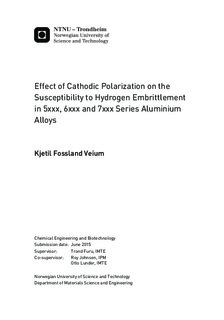Effect of Cathodic Polarization on the Susceptibility to Hydrogen Embrittlement in 5xxx, 6xxx and 7xxx Series Aluminium Alloys
Abstract
Aluminium is an interesting material for use in subsea applications due to the combination of low weight, good corrosion resistance and superior low temperature properties. So far, the use of aluminium alloys in offshore applications has mainly been restricted to topside structures. In order to use these alloys in subsea structures and components, there is a need for cathodic protection (CP) to avoid corrosion in contact with more noble metals. CP represents a source of hydrogen, and this may pose a threat to hydrogen embrittlement (HE).
In this study the effect of cathodic polarization on the susceptibility to HE in several variants of Al-Mg (5xxx), Al-Mg-Si (6xxx) and Al-Zn-Mg (7xxx) aluminium alloys was investigated. A stepwise loading tensile test with in situ cathodic polarization was performed on hydrogen pre-charged samples and on not pre-charged samples. In addition, reference samples were tensile tested in air. Fracture surfaces were examined using scanning electron microscope (SEM), and reduction of area (RA) measurements were also performed. The planned measurements of hydrogen content and microhardness were not conducted.
The results from this study indicate an effect of cathodic polarization on the susceptibility to HE in AA 7108.50, manifested by a decline in average fracture strength (FS) between reference samples and hydrogen pre-charged samples, respectively. Moreover, features associated with transgranular cleavage fractures were revealed from fractography. The EN AW 5083 H321 and EN AW 6082 T6 alloy variants do not seem to be particularly vulnerable to HE, regardless of both composition and thermal history. Minor variations in FS were found between reference samples and hydrogen pre-charged samples, and only ductile features were revealed from the fracture surface examinations. The reduction of area (RA) measurements were not included in the overall assessment of susceptibility to HE due to large inconsistency with the other test results. It should be emphasized that measurement of hydrogen content and execution of experiments in which several parallels of samples are tested are crucial for verification of the findings from this study.
